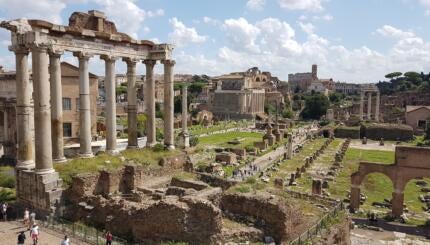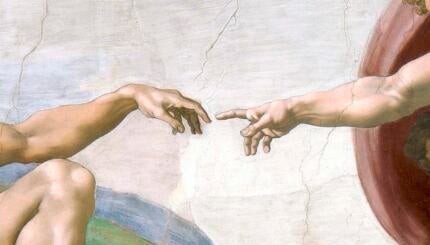This coming week begins the Hebrew month of Elul, the letters of whose name famously form an acronym for the phrase ani l’dodi v’dodi li — I am my beloved’s and my beloved is mine.
This phrase comes from Song of Songs (6:3), a poetic back and forth between a male and female each longing for the other’s love. The rabbis classically interpreted Song of Songs as an allegory for the on-again, off-again romance between God and the Jewish people, presumably because if it were not, there’s no way its raunchy, dreamy perseverations would have merited inclusion in the Bible.
We do find images of God as lover elsewhere in Jewish tradition, perhaps most notably in the Friday night liturgy. This is where a theology of hieros gamos, or sacred union, is most pronounced, as we welcome the transcendent God to cohabit with the Shabbat queen on earth, an immanent face of the manifest divine. But notwithstanding the long history of ecstatic poetry, from King Solomon’s palace through to the Renaissance mystics, in general Judaism has not organized itself around the sense of God as lover. Far more standard are images of God as king, father and creator.
Even if these conceptions of God are intended as benevolent, they are still fundamentally hierarchical. The king is in charge, and father knows best. Creator, father and king all imply a singular power, distinct from the many millions of its multifarious progeny. Unlike the unique intimacy of a beloved, these images are apt to make our deity feel rather impersonal and remote. How much individual attention can we really expect from a father whose living human children alone number more than eight billion?
With your help, My Jewish Learning can provide endless opportunities for learning, connection and discovery.
And where God is depicted as a husband or romantic partner in Jewish tradition, the implications are frequently disturbing. In his extensive use of the “faithless wife” analogy, the prophet Hosea fulminates against Israel’s adulterous attraction to other gods, an infidelity that leaves “her” legitimately deserving of violent punishment. The Book of Lamentations expresses this violence outright, drawing explicit focus to the disgraced body of Zion. She is seen not merely weeping, humiliated and scorned by her former friends, but even coded as the victim of sexual violence — “snatched at,” “raped,” “her nakedness exposed,” “with unclean blood clinging to her skirts.” This trend of depicting nation as woman continues to find expression right down to the present day, with modern Israeli authors like Amos Oz and David Grossman portraying — with rather more sensitivity than Hosea — vulnerable, tragic, frustrated heroines as embodiments of the Jewish nation-state.
Constructing the encompassing body of the nation as female (along with ships and sports teams) is not limited to Jews, and in fact is common in the wider culture. However, the Hebrew language also genders not only soul (neshamah) but self (nefesh) in the feminine. Relative to the penetrating presence of divine life-force, the containing receptacle of each individual is “female,” regardless of biological sex. At some level, this is presumably a human projection of our reproductive mechanism onto the mystery of existence: If matter is mother, some tiny animating spark of encoded intelligence from the great Other is still needed to seed creation.
Gender, then, is metaphor — in the deeper sense of the word: a splitting into parts. For as Deuteronomy 4:35 reminds us, at root “there is nothing else but God.” The supposed duality of lover and beloved must therefore be mere playfulness, a contraction of the all-pervasive Self-awareness of God precisely so that It might experience the delight of being found and known and merged with once again.
A famous midrash (Bereishit Rabbah 8:1) understands the description in Genesis of humanity’s creation as an account of primordial man and woman being separated out from one original androgynous body. This separation, say the rabbis, lets us go from being whole but unconscious of our wholeness to being able to approach one another face to face, panim el panim. It is only thus that we can see the presence of God in one another — and find ourselves as both lover and beloved, rooted into the cosmos by the experience of love itself.
And in that love we might well find that as much as I am my beloved’s and my beloved is mine, at heart I am my beloved, and My Beloved Is Me.



